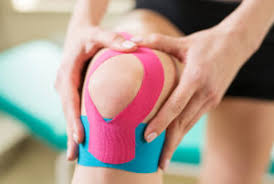One of the most popular sports medicine techniques that has gained significant popularity in recent years is kinesiotaping. This method involves the application of elastic tape to the body, providing support to muscles and joints while facilitating a range of motion. In this blog post, we’ll delve into the principles of kinesiotaping and explore how it is employed by physical therapists as a valuable tool in their treatment arsenal.
Kinesiotaping, often referred to as “KT tape,” is a therapeutic approach that originated in the 1970’s in Japan. The distinctive elastic tape used in kinesiotaping is designed to mimic the flexibility and elasticity of human skin. Unlike traditional athletic tape, which is rigid and restricts movement, KT tape allows for a full range of motion, making it an ideal choice for rehabilitation and injury prevention.
The tape’s adhesive is hypoallergenic and activated by body heat, ensuring it stays securely in place without causing irritation to the skin. Its unique properties make kinesiotaping a versatile and non-invasive intervention for various musculoskeletal conditions.

Applications in Rehabilitation and Recovery
Limitless physical therapists harness the benefits of kinesiotaping across a spectrum of conditions and treatment goals. Here are some ways in which KT tape is commonly used in clinical practice:
- Muscle Support and Activation: Kinesiotaping provides targeted support to muscles, enhancing their stability and promoting proper function. The tape’s elastic properties facilitate muscle contraction while preventing overextension, making it valuable in conditions where muscle weakness or imbalance is present.
- Pain Management: KT tape is employed as part of a comprehensive pain management strategy. By lifting the skin and creating space between the tissues, the tape helps alleviate pressure on pain receptors, reducing discomfort and promoting a sense of relief. This is particularly useful in conditions such as chronic pain, tendonitis, and overuse injuries.
- Edema Reduction: The elastic nature of KT tape aids in improving circulation and lymphatic drainage, contributing to the reduction of swelling and edema. This is especially beneficial in the early stages of injury or post-surgery recovery.
- Posture Correction: Physical therapists use kinesiotaping to encourage better posture and alignment. The tape can be strategically applied to provide sensory feedback, prompting individuals to maintain proper posture during daily activities and exercises.
- Joint Support: KT tape is often utilized to provide additional support to joints affected by instability or injury. By offering dynamic support without restricting movement, the tape assists in maintaining joint alignment and function.

Neuromuscular Reeducation: Kinesiotaping plays a role in neuromuscular reeducation by influencing proprioception—the body’s awareness of its position in space. The tape provides sensory input that helps improve motor control and coordination, aiding in the rehabilitation of movement patterns.
In the realm of sports medicine, kinesiotaping has emerged as a versatile and effective tool, offering a range of benefits from muscle support to pain management and beyond. Its non-invasive nature, coupled with the ability to enhance the body’s natural healing processes, makes it a valuable adjunct to traditional rehabilitation techniques.
If you would like to learn more about kinesiotaping and how it might benefit you, give us a call or fill out the contact form here on our website!



